Analyzing Intel Core M Performance: How 5Y10 can beat 5Y71 & the OEMs' Dilemma
by Brett Howse & Ian Cutress on April 8, 2015 8:00 AM ESTCinebench R15 Multi-Threaded Results
Looking at a multi-threaded run of Cinebench, the devices which will perform the best are going to need to have enough thermal headroom to keep all of the cores working at a good pace. All of these devices have four logical cores mapped to two physical cores via Hyperthreading, all of which are run at maximum load for the duration of this test.
The Core i5 once again has no issues maintaining its high CPU frequency, even though the overall SoC temperature does get higher than the single-threaded run. The Dell Venue 11 Pro tablet though starts off really reaching for the stars, but quickly must throttle back until it finds a consistent range that allows it to stay within its cooling constraints. The Yoga 3 Pro is similar, but quickly falls back due to the 65°C limit placed on the processor by the manufacturer. The ASUS UX305 performs just as well in this test as the last, with a very consistent CPU frequency, despite the temperatures getting a bit higher than the last run.
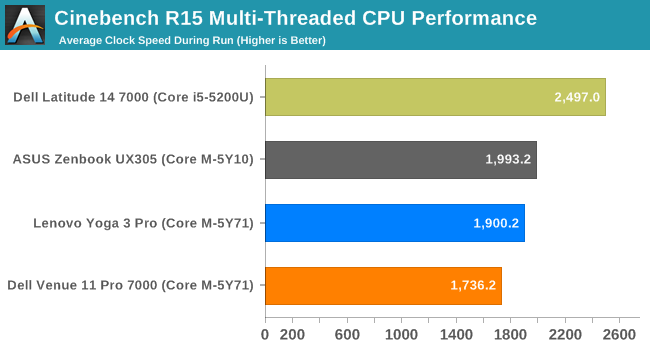
When it comes to average CPU frequency, both the Lenovo Yoga 3 Pro and the Dell Venue 11 Pro once again end up falling behind the ASUS and its much lower turbo speed in this test, though not by a huge margin. The ASUS averages the highest CPU frequency of the Core M contenders just like in the single-threaded workload, with the Lenovo less than 100MHz behind it, and the Dell Venue a ways back again. Neither of the 5Y71 devices turbo much over the 5Y10 in this test though.
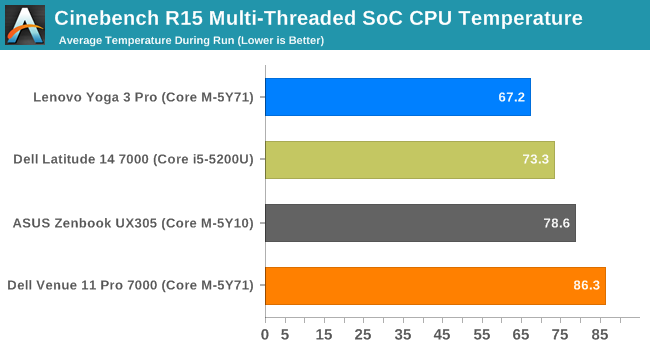
Looking at the temperatures, you can see just how conservative Lenovo has been with the Yoga 3 Pro. The overall SoC temperature is quite a bit lower than all of the other devices when the device is under load. The active cooling and low SoC temperatures help the Yoga 3 Pro to keep a cool exterior to the device.
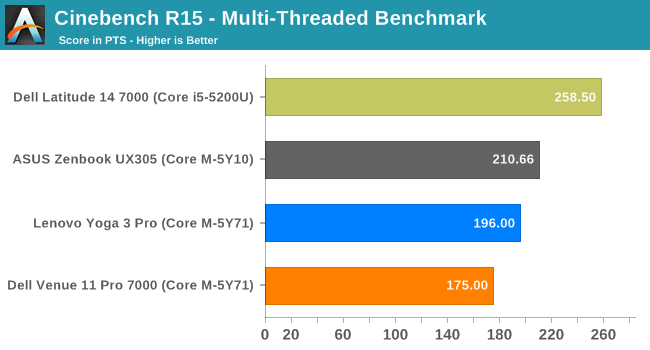
Now we come to the end result of this workload. The 5Y10 device handily outperforms both of the higher ranked models. Unsurprisingly it comes no where near the Core i5, but looking at the CPU frequency graph really demonstrates why it scores higher. Both of the 5Y71 have a lower average score, but unlike the single-threaded result, neither of them can sustain a CPU frequency past the frequency of the ASUS very much.


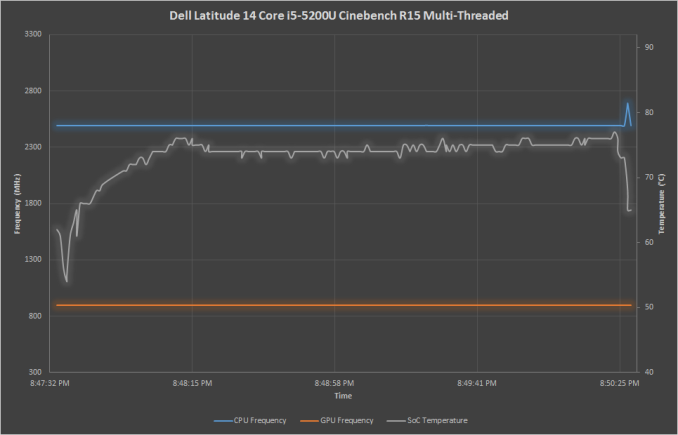
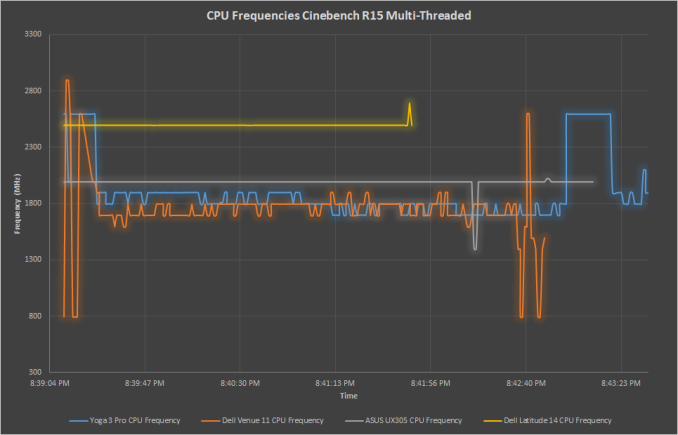
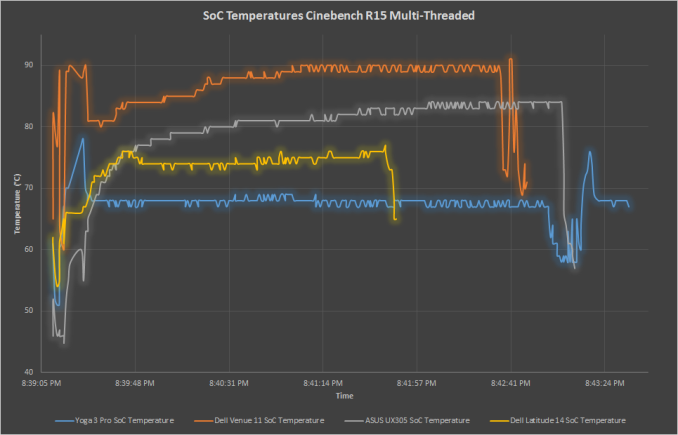








110 Comments
View All Comments
serendip - Wednesday, April 8, 2015 - link
Maybe Intel made too many compromises and OEMs reached too far with their designs. On one hand a fast race to sleep is good, yet on the other hand, I'd rather be a slow and steady tortoise who finishes the race than a hare that turbos and sleeps frequently to prevent overheating. Device buyers don't care about TDP or poorly set skin temperature limits, they'll just swear off Core M products that give them throttled 600 MHz speeds instead of full power.boblozano - Wednesday, April 8, 2015 - link
Good point, though I tend to think it'll depend on the use cases. I went back to separate desktop(s) / laptop (rather than a single, uber-laptop) about a year ago. Consequently the laptop can be optimized for size / weight / mobility, for which a core-m device is helpful.jospoortvliet - Thursday, April 9, 2015 - link
Exactly the same here. I will do my video and image editing on my quad-core desktop anyway, so a core M is perfect: I need portability and battery life in a laptop, not raw performance. Intel made just the right chip for a customer like me here. Too bad that on the desktop side, where I would love an affordable six or eight core with a high tdp, they fail me.girishp - Monday, April 13, 2015 - link
I tried doing the same thing, but portability quickly triumphs any advantage of a powerful desktop, especially when a good powerful laptop can do most of what I need. I bought the 2nd gen Mac Book Air for my wife and it was good for her basic multimedia requirements (Photoshop, Final Cut Pro, etc.), but the latest Mac Book just isn't powerful enough for any of her needs.MrSpadge - Wednesday, April 8, 2015 - link
Turbo gives the system increased responsiveness under bursty loads, i.e. most everyday workloads. There's no good reason not to use the performance available and be a tortoise voluntarily. When the load is sustained over longer periods, Turbo automatically throttles back to what ever limit the OEM has set. Had you choosen the tortoise mode, you would have started at this point. With Turbo you don't loose any performance compared to this scenario, it just makes you reach the limit quicker. Turbo also autoamtically factors in things like "how many cores are loaded", "how stresful is this program in reality", "how good is the device cooling" and "how hot is the ambient" by simply measuring them empirically (power consumption & temperature). In fixed tortoise mode you'd have to predict all of them and assume the worst case, just like Intel & AMD did for the first dual and quad cores with low fixed frequencies.If Turbo results in "turbos and sleeps frequently to prevent overheating" it is simply set up badly, significantly worse than Turbo on Intel Desktop CPUs since a few years. Instead of sleeping to avoid overheating the turbo bin must gradually be lowered until a good steady state is reached.
MrSpadge - Wednesday, April 8, 2015 - link
Forgot to add: it would be really nice if there was a simple user control for their current preference of maximum performance vs. tolerated temperature. Win allows limiting a CPUs maximum performance state, but most users will never find this option in the advanced energy settings. A simple slider as a sidebar-like gadget could work well. Not only for Core-M, but also for regular laptops and desktops. Add one slider for each discrete GPU's power target.mkozakewich - Wednesday, April 8, 2015 - link
Also, MS removed that option in all their PCs with connected standby. You can still enable it through the registry, but regular users are even less likely to make use of that option. We need some sane defaults set so we can have separate "Low Power", "Balanced" and "Overdrive" modes. We won't care about skin temperature if we've chosen to use that temperature briefly and we have an option to turn it back down.soccerballtux - Wednesday, April 8, 2015 - link
the biggest problem is Windows packaging in tons of storage indexing that runs every time you log in, or letting services run around in the background and datamine (Facebook, Amazon Music re-scans every 10 minutes-- I mean seriously? might as sell me a phone with 100MB less of RAM if you're going to do that)The_Assimilator - Wednesday, April 8, 2015 - link
Because it's obviously Windows' fault that it runs services that you told it to install.lilmoe - Thursday, April 9, 2015 - link
+1